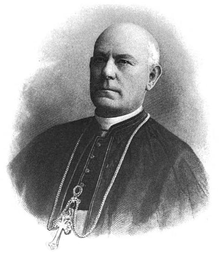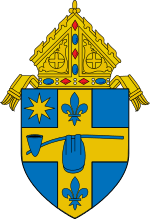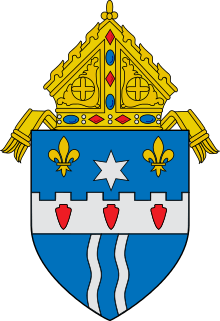John Lancaster Spalding
John Lancaster Spalding (June 2, 1840 – August 25, 1916) was an American author, poet, advocate for higher education, the first bishop of the Roman Catholic Diocese of Peoria from 1877 to 1908[1] and a co-founder of The Catholic University of America.
John Lancaster Spalding | |
|---|---|
| Bishop of Peoria | |
 | |
| Church | Roman Catholic |
| See | Diocese of Peoria |
| In office | May 23, 1877 – September 11, 1908 (retired) |
| Successor | Edmund Michael Dunne |
| Orders | |
| Ordination | December 19, 1863 |
| Personal details | |
| Born | June 2, 1840 Lebanon, Kentucky, USA |
| Died | August 25, 1916 Peoria, Illinois, USA |
The diocesan offices of the Diocese of Peoria are located in the Spalding Center, named for him. Peoria's Catholic high school for boys, Spalding Institute, was named for him. The school closed in the 1988-1989 school year when it merged with Bergan High School to form Peoria Notre Dame High School. Spalding Hall at The Catholic University of America was also named for him.
Early years
John Lancaster Spalding was born on June 2, 1840, in Lebanon, Kentucky. He was graduated in 1856 from St. Mary's College in St. Mary's, Kentucky,[2] which had been founded by William Byrne and George Elder. The Spaldings and the Elders were related by marriage, Thomas Elder having married Elizabeth Spalding. Elizabeth was the paternal aunt of Catherine Spalding, co-founder of the Sisters of Charity of Nazareth. Thomas and Elizabeth were the grandparents of William Henry Elder, Archbishop of Cincinnati.
He attended Mt. St. Mary College in Emmitsburg, Maryland briefly, before graduating in 1859 from Mount St. Mary's Seminary of the West in Cincinnati.[2] His uncle, Martin John Spalding, was bishop of Louisville,[3] and arranged for him to attend the American College of the Immaculate Conception in Louvain, Belgium.[4]
Following his ordination on December 19, 1863, in Louvain, the twenty-three year old Spalding continued his studies as the Belgian Pontifical College in Rome. He returned in 1865 to become assistant pastor of the Cathedral of the Assumption in Louisville, Kentucky. In 1866 he attended the Second Plenary Council of Baltimore as theologian to François Norbert Blanchet, Archbishop of Oregon City.[2]
In 1872, he went to New York to write a biography of his late uncle, and became assistant pastor of the Church of St. Michael on 34th Street.[3]
Bishop
On November 11, 1876, Pope Pius IX appointed Spalding as the bishop of the Roman Catholic Diocese of Peoria, newly created out of part of the Diocese of Chicago. He was installed as the first Bishop of Peoria on May 23, 1877 by Cardinal John McCloskey, Archbishop of New York,[5] with Thomas Patrick Roger Foley, Coadjutor Bishop of the Diocese of Chicago presiding.[6]
As bishop, Spalding greatly valued education. He was instrumental in the founding of The Catholic University of America in Washington, D.C.,[7] as well as several Catholic schools in Peoria.[8] He also oversaw the construction of St. Mary's Cemetery just outside Peoria (now in West Peoria, Illinois).[6]
In 1876, six Sisters of the Third Order of St. Francis, at the request of Reverend Bernard Baak, pastor of St. Joseph, arrived from Iowa City to care for the sick. They served at the city hospital and made home visits. Shortly after arriving, Bishop Spalding visited the hospital and observing the difficult conditions the sisters worked under, encouraged them to form a separate congregation with his support. As the Mother Superior had no objections, the Sisters of the Third Order of St. Francis of Peoria was established in July 1877. St. Francis Hospital opened in 1878. It is now OSF Saint Francis Medical Center.[9]
Bishop Spalding achieved national prominence for helping President Theodore Roosevelt and J. P. Morgan to end the Great Coal Strike of 1902 as a member of the Arbitration Commission that awarded the miners a retroactive 10% wage increase and reduced daily work hours from 10 to 9.[10]
Spalding wrote several books, including a biography of his uncle Archbishop Martin John Spalding, and poetry under the pseudonym Henry Hamilton.[6]
The Third Plenary Council of Baltimore of 1884 authorized a commission be established to create a uniform catechism. Spalding and Monsignor Januarius de Concilio of Seton Hall prepared a draft and distributed it to the bishops, who were to forward their revisions to Spalding, who would, in turn, report back at the next meeting. Anticipating long and fruitless discussion, Spalding dispensed with procedure and sent the draft to archbishop James Gibbons, indicating that he had made suggested changes where appropriate. Cardinal John McCloskey of New York gave it the imprimatur, Gibbons approved the text, and it was published in April 1885. Though not universally applauded, the Baltimore Catechism remained the standard catechism in the United States for the next eighty years.[11]
Spalding was awarded an honorary degree from Columbia University in 1902, and from Western Reserve University in 1904.[12]
Spalding became paralyzed from a stroke in 1905 and, as a result,[6] retired on September 11, 1908, at the age of 68 and was appointed Titular Bishop of Scythopolis, by Pope Pius X.[5] He died on August 25, 1916.[5]
Caldwell sisters
William Shakespeare Caldwell, a wealthy gas company executive, was married to Mary Eliza Breckinridge of the Kentucky Breckinridges. Although Protestant, Mary Eliza had attended Nazareth Academy founded by the Sisters of Charity of Nazareth,[13] and was subsequently baptized Catholic by Bishop Spalding of Louisville. When Mrs. Caldwell died unexpectedly in 1867, "Shake" sought solace in his wife's religion. He founded Sts. Mary and Elizabeth Hospital in Louisville, run by the Sisters of Charity, in her memory; and a home for indigent men in Richmond, operated by the Little Sisters of the Poor. Caldwell moved to New York and enrolled his two daughters, Mary Guendaline and Mary Elizabeth in the Academy of the Sacred Heart on 17th Street. Caldwell died in 1874. Under the terms of his will, he subsidized ten places in the Richmond home for poor individuals of Fredericksburg; He also stipulated that upon reaching the age of twenty-one, his daughters were to donate one-third of their substantial inheritance to establish a Catholic university.[14][15]
When Mary Guendaline was 21, she gave the money to buy the land for Catholic University and to build Caldwell Hall, which was named after her. Mary Elizabeth funded Caldwell Hall's chapel. Mary Elizabeth married Moritz, Baron von Zedtwitz, German Minister to Mexico, and converted to Lutheranism. The sisters travelled extensively in Europe. In 1896, Mary Guendaline married the middle-aged Francois Jean Louis, Marquis de Montieres-Merrinville in Paris. Bishop John Spalding of Peoria performed the ceremony. In 1904, the sisters broke with the Catholic Church, the Marquise stating that her "honest Protestant blood had asserted itself".[15] She requested that her portrait in Caldwell Hall be removed. According to the New York Times, her actions provoked little surprise as she was in poor health having suffered a stroke two years earlier and "[t]he Marquise is an original character and extremely impulsive."[16] The Marquise separated from her husband in 1905, but paid him an annual stipend of $8,000 in order to keep her title.
In 1906, Mary Elizabeth's book, The Double Doctrine of Rome, in which she takes issue with "Popery", its beliefs, and practices, was published.[17] That same year she sent a letter to The Converted Catholic, stating that Spalding was never their guardian, nor had her parents ever met him.[18]
Spalding was later accused of having an affair with both sisters though the allegation was questionable.[19] The potential for scandal cost Spalding appointment to the See of Chicago and he remained Bishop of Peoria. "[T]here is general consensus that the sisters’ stories about Spalding bore little relation to the facts, that their tragic marriages and psychic illnesses, plus Spalding’s unwillingness to arrange an annulment for Mary Elizabeth, contributed to their turning against the church."[20]
Publications

- Essays and Reviews[6]
- Lectures and Discourses[6]
- Education and the Higher Life[6]
- The Poet's Praise (as Henry Hamilton)[6]
- Opportunity and Other Essays (as Henry Hamilton)[6]
- Aphorisms and Reflections[6]
- Socialism and Labor[6]
- Brilliants, From the Writings of Rt. Rev. J. L. Spalding, D.D.[6]
Legacy
The Diocese of Peoria has established the John Lancaster Spalding Scholarship, a tuition assistance program for students in any parish to attend any Catholic school in the diocese.[21]
References
- John Lancaster Spalding Archived 2007-09-28 at the Wayback Machine, Historic Peoria
- Cosgrove, J.J., Most Reverend John Lancaster Spalding, First Bishop of Peoria, Wayside Press, 1960
- ""Archbishop John Lancaster Spalding", Franciscan Sisters of Peoria". Archived from the original on 2019-07-25. Retrieved 2019-08-22.
- Nolan, L. A. (2005). "John Lancaster Spalding (1840-1916): A Catalyst for Social Reform". Journal of Catholic Education, 9 (2). December, 2005]
- "Bishop John Lancaster Spalding †". Catholic-Hierarchy. 2007-10-06. Retrieved 2008-01-12.
- Aspell, Albina. "Bishop John Lancaster Spalding". The Catholic Post. Roman Catholic Diocese of Peoria. Retrieved 2008-01-12.
- "Archived copy". Archived from the original on 2007-07-19. Retrieved 2007-08-19.CS1 maint: archived copy as title (link)
-

- OSF Healthcare
- Doris K. Goodwin, The Bully Pulpit (Simon & Schuster, 2013) p. 318
- Mongoven, Anne Marie. The Prophetic Spirit of Catechesis, Paulist Press, 2000, p. 41ISBN 9780809139224
- Nuesse, C. Joseph. The Catholic University of America: A Centennial History, CUA Press, 1990. p. 14, n.44ISBN 9780813207360
- "A Famous Convent School of the Southwest", Catholic World, Issues 334-336, Paulist Fathers, 1893, p. 481

- Fox-Sheinwold, Patricia. "Caldwell, Mary Gwendolin Byrd", American National Biography
- Interview, New York Times, November 16, 1904
- Shenton, James P. "Caldwell, Mary Gwendolyn", Notable American Women, (Edward T. James, Janet Wilson James, Paul S. Boyer, eds.), Harvard University Press, 1971 ISBN 9780674627345
- Baroness von Zedtwitz (1906), The Double Doctrine of Rome, New York: Revell.
- The Converted Catholic, Volumes 22-23, Christ's Mission, 1905, p. 179

- Gollar, C. Walker."Spalding, John Lancaster", Encyclopedia of Louisville, (John E. Kleber, ed.) University Press of Kentucky, 2015}ISBN 9780813149745,
- Quigley, Tom.[https://www.americamagazine.org/content/all-things/his-kind-town-blase-cupich-becomes-part-colorful-history "His kind of town: Blase Cupich becomes part of a colorful history", America, November 19, 2014}
- "John Lancaster Spalding Scholarship", St. Ann Catholic Church, January 2, 2011
Further reading
- Curti, Merle. The Social Ideas of American Educators (1935) pp 348–73
- Sweeney, David Francis. The Life of John Lancaster Spalding: First Bishop of Peoria, 1840-1916 (Vol. 1. Herder and Herder, 1966)
External links
| Wikiquote has quotations related to: John Lancaster Spalding |
- Works by John Lancaster Spalding at Project Gutenberg
- Works by or about John Lancaster Spalding in libraries (WorldCat catalog)
- Works by or about John Lancaster Spalding at Internet Archive
- Loyola Marymount University: Digital Commons @ LMU and LLS: Catholic Education: A Journal of Inquiry and Practice: July 2013 issue: "John Lancaster Spalding (1840-1916): A Catalyst for Social Reform"
- Biola University: Talbot School of Theology: John Lancaster Spalding
- The Sisters of the Third Order of St. Francis: Archbishop John Lancaster Spalding
- Rev John Lancaster Spalding at Find a Grave
| Catholic Church titles | ||
|---|---|---|
| Preceded by None |
Bishop of Peoria 1877–1908 |
Succeeded by Edmund Michael Dunne |
| Preceded by Joseph-Marie Raya |
Titular Bishop of Scythopolis 1908–1916 |
Succeeded by Antonio Tani |

